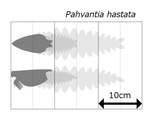Biology:Pahvantia
| Pahvantia | |
|---|---|

| |
| Fossil specimens of Pahvantia hastata | |
| Scientific classification | |
| Domain: | Eukaryota |
| Kingdom: | Animalia |
| Phylum: | Arthropoda |
| Class: | †Dinocaridida |
| Order: | †Radiodonta |
| Family: | †Hurdiidae |
| Genus: | †Pahvantia Robison & Richards, 1981 |
| Type species | |
| Pahvantia hastata Robison & Richards, 1981
| |
Pahvantia is an extinct genus of hurdiid radiodont from the Cambrian. It is known by a single species, Pahvantia hastata, described from Wheeler Shale and Marjum Formation in Utah.[1][2] Although it was once considered as filter feeder using large number of putative setae,[1][3] this structures are later considered as misidentification of trunk materials.[4][5]
Description
Genus name Pahvantia is named after Pahvant in western Utah.[6] It was originally described as possible arthropod with unknown affinity. One specimen is described as a specimen of Proboscicaris agnosta, which is originally interpreted as bivalved arthropod, and now considered as head sclerites of Hurdia.[6][1]
Pahvantia is a relatively small radiodont with estimated length up to 25 centimetres (9.8 in). Similar to most of other hurdiid, Pahvantia had large dorsal head sclerite (H-element), and it was more than twice longer than wide.[1] Based on frontal appendage, its morphology is most close to that of Hurdia, although shape of sclerites are enough different to consider Pahvantia as distinct genus.[5]
Interpretation of frontal appendage
Lerosey-Aubril and Pates (2018) considered fossil specimen KUMIP 314819 as frontal appendage with a multitude of long hair-like structures tentatively interpreted as setae hereafter. It was interpreted that frontal appendage had two different types of endites, two proximal short ones with robust plate-like structures with different widths, and five, apparently unpaired ones that are two to three times wider and around three times longer, with anterior margins that fringed by numerous setae.[1] However, Moysiuk and Caron (2019) questioned this interpretation, with reasons such as unnatural fossil preservation against flexibility of structures, no differentiation between podomeres and endites that Lerosey-Aubril and Pates (2018) interpreted, too large frontal appendage size compared to other hurdiids. It was considered that whole morphology of "frontal appendage" shows several bands of lamellae and possibly represent disarticulated endites. Due to preservation status, researchers considered that morphology of frontal appendage is uncertain.[4] In 2021, Moysiuk and Caron reinterpreted morphology of Pahvantia hastata with description of Titanokorys. Researchers compared the part and counterpart of specimen KUMIP 314819, and they found actual part shows Hurdia-like frontal appendage. "two proximal short endites with different widths" Lerosey-Aubril and Pates (2018) interpreted actually shows one endite and three overlapped endites. Other "five endites with numerous setae" are more comparable to gill blades (setal blades) on trunk segments.[5]
Palaeoecology
Pahvantia was originally interpreted as one of the examples of suspension feeding radiodont alongside Aegirocassis and Tamisiocaris, used numerous setae on frontal appendage to capture microscopic food particles suspended in the water column.[1] However, after morphology of frontal appendage is reinterpreted, it is estimated that Pahvantia probably had nektobenthic lifestyle, captured larger prey living along or in the sediment, according to morphology of frontal appendage similar to Hurdia.[5]
References
- ↑ 1.0 1.1 1.2 1.3 1.4 1.5 "New suspension-feeding radiodont suggests evolution of microplanktivory in Cambrian macronekton". Nature Communications 9 (1): 3774. September 2018. doi:10.1038/s41467-018-06229-7. PMID 30218075.
- ↑ "The diverse radiodont fauna from the Marjum Formation of Utah, USA (Cambrian: Drumian)". PeerJ 9: e10509. 2021-01-19. doi:10.7717/peerj.10509. PMID 33552709.
- ↑ "First report of paired ventral endites in a hurdiid radiodont". Zoological Letters 5 (1): 18. 2019-06-11. doi:10.1186/s40851-019-0132-4. PMID 31210962.
- ↑ 4.0 4.1 "A new hurdiid radiodont from the Burgess Shale evinces the exploitation of Cambrian infaunal food sources". Proceedings. Biological Sciences 286 (1908): 20191079. August 2019. doi:10.1098/rspb.2019.1079. PMID 31362637.
- ↑ 5.0 5.1 5.2 5.3 "A giant nektobenthic radiodont from the Burgess Shale and the significance of hurdiid carapace diversity". Royal Society Open Science 8 (9): 210664. September 2021. doi:10.1098/rsos.210664. PMID 34527273.
- ↑ 6.0 6.1 "Larger bivalve arthropods from the middle Cambrian of Utah". University of Kansas Paleontological Contributions 106: 1–28. January 1981. https://www.researchgate.net/publication/29444322.
Wikidata ☰ Q113550283 entry
 |







